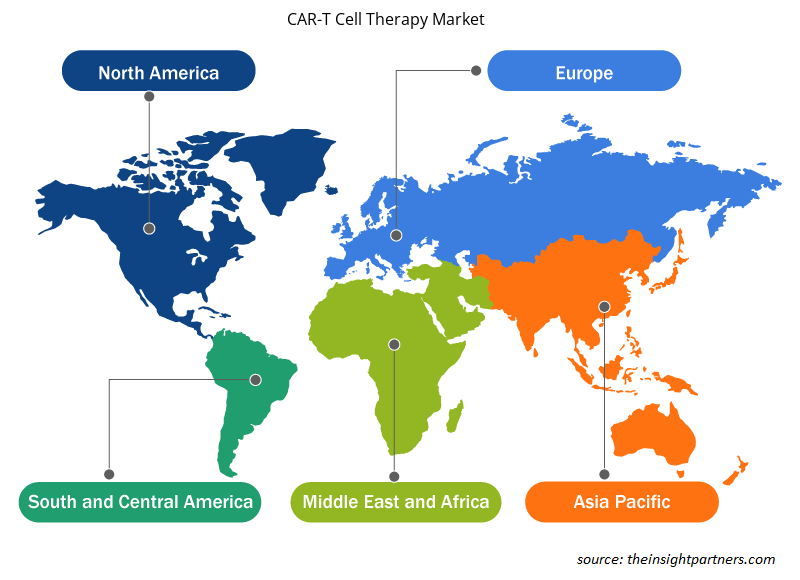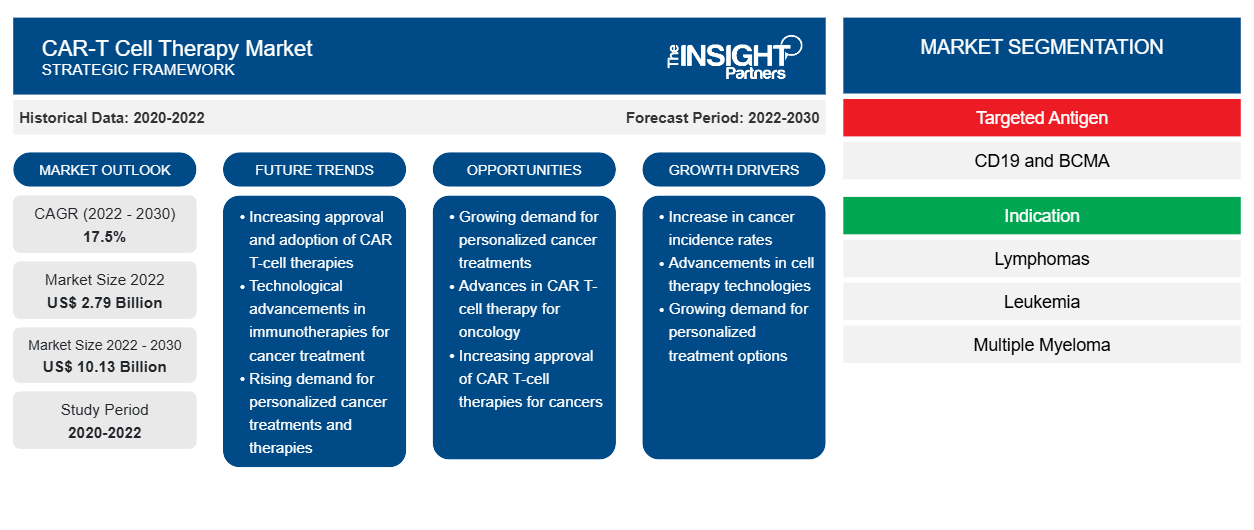[研究报告] CAR-T细胞治疗市场规模预计将从2022年的27.9亿美元增至2030年的101.3亿美元;预计2022-2030年期间的复合年增长率为17.5%。
市场洞察和分析师观点:
治疗癌症最有前景的方法之一是嵌合抗原受体 (CAR) T 细胞疗法,每年都会进行大量的临床前和临床试验以增加其应用。经过数十年的研究,CAR-T 细胞疗法必将得到扩展。除了自体和同种异体产品外,未来的细胞疗法还将研究新的体内 CAR-T 细胞基因疗法和血液系统恶性肿瘤以外适应症的疗效。然而,商业化挑战阻碍了CAR-T 细胞疗法市场的增长。
增长动力:
癌症发病率上升推动 CAR-T 细胞治疗市场
CAR-T 细胞疗法是一种新的癌症治疗方法。T 细胞在实验室中进行改造,然后返回体内以靶向癌细胞。成人和儿童白血病以及某些类型的淋巴瘤都可通过 CAR-T 细胞疗法进行治疗。此外,人们正在研究将其作为其他癌症(如胸部出现的某些实体瘤)的潜在治疗方法。
遗传易感性、加工食品、污染和生活方式的改变是导致癌症患病率上升的因素。据美国癌症协会估计,2020 年全球新增癌症病例约 1930 万例。因此,癌症患者数量的增加推动了对 CAR-T 细胞疗法的需求。
定制此报告以满足您的需求
您可以免费定制任何报告,包括本报告的部分内容、国家级分析、Excel 数据包,以及为初创企业和大学提供优惠和折扣
- 获取此报告的关键市场趋势。这个免费样品将包括数据分析,从市场趋势到估计和预测。
报告细分和范围:
“CAR-T细胞治疗市场分析”是通过考虑以下部分来进行的:靶抗原、适应症和最终用户。
节段分析:
根据靶向抗原,CAR-T 细胞治疗市场分为 CD19 和 BCMA。CD19 细分市场在 2022 年占据了较大的 CAR-T 细胞治疗市场份额,预计在预测期内将实现 17.9% 的复合年增长率。
CAR-T 细胞可有效治疗复发/难治性弥漫性大 B 细胞淋巴瘤。患者的 T 细胞经过基因改造,可产生 CD19 CAR T 细胞。经过改造的 T 细胞可表达与白血病和淋巴瘤癌细胞中高表达的 CD19 蛋白结合的受体。
CD19 CAR-T 细胞治疗产品的上市预计将推动该领域的增长。以下是美国食品药品管理局和欧盟分别在美国和欧洲批准的产品清单:
制造商 | 品牌产品 | 靶抗原 | 疾病指征 | 核准年份 | |
诺华 | 凯姆里阿 | CD19 | 白血病 | 2017 | |
吉利德科学公司 | 耶斯卡塔 | CD19 | 淋巴瘤 | 2017 | |
吉利德科学公司 | 泰卡图斯 | CD19 | 淋巴瘤和白血病 | 2020 | |
百时美施贵宝 | 布雷扬齐 | CD19 | 淋巴瘤 | 2021 |
CAR-T 细胞治疗市场按适应症分为淋巴瘤、白血病和多发性骨髓瘤。淋巴瘤细分市场在 2022 年占据了较大的市场份额,预计在预测期内将实现 18.1% 的更高复合年增长率。急性淋巴细胞白血病、慢性淋巴细胞白血病、淋巴瘤和多发性骨髓瘤等血液系统恶性肿瘤一直是使用 CAR-T 细胞的主要适应症。
CAR-T 细胞治疗市场按最终用户分为医院和专科诊所、门诊手术中心和其他。医院和专科诊所部分在 2022 年占据最大市场份额,预计在预测期内将录得最高复合年增长率 17.9%。
技术进步加速 CAR-T 细胞治疗市场扩张
CAR-T 疗法的发明和推出是过去几年最伟大的医学进步之一,该疗法利用患者的白细胞对抗特定形式的血癌细胞。一些癌症患者可能会从 CAR-T 细胞疗法中找到治愈癌症的希望。自 2017 年第一种疗法获批用于治疗特定类型的成人和儿童白血病、淋巴瘤和多发性骨髓瘤以来,美国食品药品管理局 (FDA) 已批准了另外五种 CAR-T 细胞疗法。目前还在进行研究,以开发针对实体瘤癌症的类似疗法。
同种异体 CAR-T 细胞疗法已成为全球数百项临床前和临床试验的主题。其中大部分用于血液系统恶性肿瘤,其中最常用的靶点是 CD19,还有其他传统靶点,例如 CD20、CD22 和 BCMA。还包括新开发的靶点,例如 CD70、CD7 和 CD5。新兴的实体肿瘤治疗方法包括间皮素、GD2 和 NKG2DL。
因此,细胞治疗的进步可能会在未来几年带来新的 CAR-T 细胞治疗市场趋势。
区域分析:
全球 CAR-T 细胞治疗市场报告的范围集中在北美、欧洲、亚太地区、南美和中美以及世界其他地区。2022 年,北美占据了最大的 CAR-T 细胞治疗市场份额。该地区市场的增长是由主要制造商推出的产品数量不断增加以及主要市场参与者的存在所推动的。此外,预计各制药和生物技术公司以及学术和研究机构的广泛研发将刺激北美市场的增长。例如,2022 年 6 月,百时美施贵宝宣布获得美国食品和药物管理局 (FDA) 批准 CD19 导向的 CAR-T 细胞疗法 Breyanzi (lisocabtagene maraleucel),用于治疗大 B 细胞淋巴瘤 (LBCL) 成人患者,包括弥漫性大 B 细胞淋巴瘤 (DLBCL)。
在美国,CAR-T 细胞疗法市场的增长主要由不断增长的制药和生物制药行业推动,该行业的特点是技术进步和灵活性不断提高。此外,美国制药和生物技术公司增加研发投资以改善临床试验结果并确保患者安全,刺激了市场增长。例如,2021 年 7 月,BioNTech SE 和吉利德旗下的 Kite 公司签署了一项购买协议,允许 BioNTech 购买 Kite 位于马里兰州盖瑟斯堡的临床制造工厂以及其实体肿瘤新抗原 T 细胞受体 (TCR) 研发平台。新的盖瑟斯堡工厂补充了 BioNTech 目前位于德国伊达尔-奥伯施泰因的细胞疗法制造工厂,并提供制造能力以加强美国的临床试验。该工厂有助于推进该公司不断增长的创新细胞疗法产品线,其中包括基于 NEOSTIM 和 CAR-T 细胞扩增 mRNA 疫苗 (CARVac) 的癌症候选产品以及最近收购的个性化新抗原 TCR 项目。
未来机遇和研究发展:
CAR-T 细胞疗法在癌症治疗中已显示出良好的效果;然而,它们的使用仅限于某些复发和耐药的液体肿瘤患者。在未来几年,美国再生医学的几种 CAR-T 细胞疗法和欧洲先进治疗医疗产品预计将获得市场授权。数百家不同的关键参与者正在开发创新技术,用于广泛的适应症。从长远来看,这些治疗方法可以通过一次剂量提供实质性的甚至是治愈性的健康益处来改善患者的治疗效果。
鉴于正在进行的临床试验数量和针对各种适应症开发的新型 CAR-T 细胞产品数量,CAR-T 细胞治疗的未来前景十分光明。研究人员积极研究提高 CAR-T 细胞疗效的方法,因为在接受过大量治疗的复发/难治性恶性肿瘤患者中观察到了完全缓解率和无进展生存期。
研究人员正在研究抗原丢失等可能导致免疫逃逸的因素,并想出应对方法。创建同时针对多种抗原的 CAR-T 细胞疗法就是这样一种策略。正在开发针对抗原的新药物,例如 CD138 和 GPRC5D。相比之下,针对 ALL 和 NHL 的 CAR-T 细胞疗法针对 CD19 抗原,而针对多发性骨髓瘤的疗法则针对 BCMA 抗原。
CAR-T 细胞治疗市场预测可以帮助该市场的利益相关者规划其增长战略。以下列出了 CAR-T 细胞治疗市场领先企业的一些研究和开发成果:
- 2023年11月,Vittoria Biotherapeutics宣布完成一轮私募融资,募资逾1500万美元,将用于开展VIPER-101临床试验,VIPER-101是一种自体双群体CD5敲除CAR-T细胞疗法,用于治疗T细胞淋巴瘤。
- 2023 年 12 月,阿斯利康宣布收购 Gracell Biotechnologies Inc.,以补充阿斯利康现有的能力和之前在细胞疗法方面的投资。
- 2021 年 12 月,美国加州大学圣地亚哥分校医学院的研究人员获得了 410 万美元的资助,以支持他们创新的 CAR-T 细胞疗法的推进。这笔资金由美国加州再生医学研究所理事会批准,可能使该小组能够将新型癌症治疗方法从实验室推进到患者病床上。
CAR-T 细胞治疗市场区域洞察
Insight Partners 的分析师已详尽解释了预测期内影响 CAR-T 细胞治疗市场的区域趋势和因素。本节还讨论了北美、欧洲、亚太地区、中东和非洲以及南美和中美洲的 CAR-T 细胞治疗市场细分和地理位置。

- 获取 CAR-T 细胞治疗市场的区域特定数据
CAR-T 细胞治疗市场报告范围
| 报告属性 | 细节 |
|---|---|
| 2022 年市场规模 | 27.9亿美元 |
| 2030 年的市场规模 | 101.3亿美元 |
| 全球复合年增长率(2022 - 2030 年) | 17.5% |
| 史料 | 2020-2022 |
| 预测期 | 2022-2030 |
| 涵盖的领域 | 根据靶抗原
|
| 覆盖地区和国家 | 北美
|
| 市场领导者和主要公司简介 |
|
CAR-T 细胞治疗市场参与者密度:了解其对业务动态的影响
CAR-T 细胞治疗市场正在快速增长,这得益于终端用户需求的不断增长,而这些需求又源于消费者偏好的不断变化、技术进步以及对产品优势的认识不断提高等因素。随着需求的增加,企业正在扩大其产品范围,进行创新以满足消费者的需求,并利用新兴趋势,从而进一步推动市场增长。
市场参与者密度是指在特定市场或行业内运营的企业或公司的分布情况。它表明在给定市场空间中,相对于其规模或总市场价值,有多少竞争对手(市场参与者)存在。
在 CAR-T 细胞治疗市场运营的主要公司有:
- 百时美施贵宝公司
- 诺华公司
- 吉利德科学公司
- 强生服务公司
- 科济生物科技股份有限公司
免责声明:上面列出的公司没有按照任何特定顺序排列。

- 了解 CAR-T 细胞治疗市场主要参与者概况
竞争格局和重点公司:
百时美施贵宝公司、诺华公司、吉利德科学公司、强生服务公司、科创生物技术有限公司、奥罗拉生物制药公司、传奇生物科技公司、辉瑞公司、蓝鸟生物公司、Mustang Bio、Sorrento Therapeutics 公司和 Fate Therapeutics 是 CAR-T 细胞治疗市场报告中介绍的知名公司。这些公司专注于开发新技术、升级现有产品并扩大其地理覆盖范围,以满足全球日益增长的消费者需求。
- 历史分析(2 年)、基准年、预测(7 年)及复合年增长率
- PEST 和 SWOT 分析
- 市场规模价值/数量 - 全球、区域、国家
- 行业和竞争格局
- Excel 数据集


- Small Internal Combustion Engine Market
- Neurovascular Devices Market
- Electronic Signature Software Market
- Vision Care Market
- Oxy-fuel Combustion Technology Market
- Diaper Packaging Machine Market
- Sexual Wellness Market
- Adaptive Traffic Control System Market
- Fishing Equipment Market
- Employment Screening Services Market

Report Coverage
Revenue forecast, Company Analysis, Industry landscape, Growth factors, and Trends

Segment Covered
This text is related
to segments covered.

Regional Scope
North America, Europe, Asia Pacific, Middle East & Africa, South & Central America

Country Scope
This text is related
to country scope.
常见问题
Chimeric antigen receptor (CAR)-T cell therapy is a kind of cancer immunotherapy treatment that makes use of T cells, which are immune cells, that have undergone genetic alteration in a lab to improve their ability to recognize and eliminate cancer cells. CAR-T cell therapy is one of the newest and most promising treatments for blood cancer.
Key factors that are driving the growth of this market are new product approvals and increase in prevalence of cancer is expected to boost the market growth for the CAR-T cell therapy over the years.
The CD19 segment held the largest share of the market in the global CAR-T cell therapy market and held the largest market share in 2022.
The CAGR value of the CAR-T cell therapy market during the forecasted period of 2022-2030 is 17.5%s
The Lymphomas segment dominated the global CAR-T cell therapy market and held the largest market share in 2022.
Gilead Sciences, Inc and Bristol Myers Squibb are the top two companies that hold huge market shares in the CAR-T cell therapy market.
Global CAR-T cell therapy market is segmented by region into North America, Europe, Asia Pacific, Rest of World. North America held the largest market share of the CAR-T cell therapy market in 2022.
The CAR-T cell therapy market majorly consists of the players such Bristol-Myers Squibb Company, Novartis AG, Gilead Sciences, Inc., Johnson & Johnson Services, Inc., CARsgenTherapeutics Co., Ltd, Aurora Biopharma, Legend Biotech, Pfizer Inc., bluebird bio, Inc., Mustang Bio, Sorrento Therapeutics, Inc., and Fate Therapeutics, and amongst others.
Trends and growth analysis reports related to Life Sciences : READ MORE..
The List of Companies - CAR-T Cell Therapy Market
- Bristol-Myers Squibb Company
- Novartis AG
- Gilead Sciences, Inc.
- Johnson & Johnson Services, Inc.
- CARsgenTherapeutics Co., Ltd
- Aurora Biopharma
- Legend Biotech
- Pfizer Inc.
- bluebird bio, Inc.
- Mustang Bio
- Sorrento Therapeutics, Inc
- Fate Therapeutics
The Insight Partners performs research in 4 major stages: Data Collection & Secondary Research, Primary Research, Data Analysis and Data Triangulation & Final Review.
- Data Collection and Secondary Research:
As a market research and consulting firm operating from a decade, we have published and advised several client across the globe. First step for any study will start with an assessment of currently available data and insights from existing reports. Further, historical and current market information is collected from Investor Presentations, Annual Reports, SEC Filings, etc., and other information related to company’s performance and market positioning are gathered from Paid Databases (Factiva, Hoovers, and Reuters) and various other publications available in public domain.
Several associations trade associates, technical forums, institutes, societies and organization are accessed to gain technical as well as market related insights through their publications such as research papers, blogs and press releases related to the studies are referred to get cues about the market. Further, white papers, journals, magazines, and other news articles published in last 3 years are scrutinized and analyzed to understand the current market trends.
- Primary Research:
The primarily interview analysis comprise of data obtained from industry participants interview and answers to survey questions gathered by in-house primary team.
For primary research, interviews are conducted with industry experts/CEOs/Marketing Managers/VPs/Subject Matter Experts from both demand and supply side to get a 360-degree view of the market. The primary team conducts several interviews based on the complexity of the markets to understand the various market trends and dynamics which makes research more credible and precise.
A typical research interview fulfils the following functions:
- Provides first-hand information on the market size, market trends, growth trends, competitive landscape, and outlook
- Validates and strengthens in-house secondary research findings
- Develops the analysis team’s expertise and market understanding
Primary research involves email interactions and telephone interviews for each market, category, segment, and sub-segment across geographies. The participants who typically take part in such a process include, but are not limited to:
- Industry participants: VPs, business development managers, market intelligence managers and national sales managers
- Outside experts: Valuation experts, research analysts and key opinion leaders specializing in the electronics and semiconductor industry.
Below is the breakup of our primary respondents by company, designation, and region:

Once we receive the confirmation from primary research sources or primary respondents, we finalize the base year market estimation and forecast the data as per the macroeconomic and microeconomic factors assessed during data collection.
- Data Analysis:
Once data is validated through both secondary as well as primary respondents, we finalize the market estimations by hypothesis formulation and factor analysis at regional and country level.
- Macro-Economic Factor Analysis:
We analyse macroeconomic indicators such the gross domestic product (GDP), increase in the demand for goods and services across industries, technological advancement, regional economic growth, governmental policies, the influence of COVID-19, PEST analysis, and other aspects. This analysis aids in setting benchmarks for various nations/regions and approximating market splits. Additionally, the general trend of the aforementioned components aid in determining the market's development possibilities.
- Country Level Data:
Various factors that are especially aligned to the country are taken into account to determine the market size for a certain area and country, including the presence of vendors, such as headquarters and offices, the country's GDP, demand patterns, and industry growth. To comprehend the market dynamics for the nation, a number of growth variables, inhibitors, application areas, and current market trends are researched. The aforementioned elements aid in determining the country's overall market's growth potential.
- Company Profile:
The “Table of Contents” is formulated by listing and analyzing more than 25 - 30 companies operating in the market ecosystem across geographies. However, we profile only 10 companies as a standard practice in our syndicate reports. These 10 companies comprise leading, emerging, and regional players. Nonetheless, our analysis is not restricted to the 10 listed companies, we also analyze other companies present in the market to develop a holistic view and understand the prevailing trends. The “Company Profiles” section in the report covers key facts, business description, products & services, financial information, SWOT analysis, and key developments. The financial information presented is extracted from the annual reports and official documents of the publicly listed companies. Upon collecting the information for the sections of respective companies, we verify them via various primary sources and then compile the data in respective company profiles. The company level information helps us in deriving the base number as well as in forecasting the market size.
- Developing Base Number:
Aggregation of sales statistics (2020-2022) and macro-economic factor, and other secondary and primary research insights are utilized to arrive at base number and related market shares for 2022. The data gaps are identified in this step and relevant market data is analyzed, collected from paid primary interviews or databases. On finalizing the base year market size, forecasts are developed on the basis of macro-economic, industry and market growth factors and company level analysis.
- Data Triangulation and Final Review:
The market findings and base year market size calculations are validated from supply as well as demand side. Demand side validations are based on macro-economic factor analysis and benchmarks for respective regions and countries. In case of supply side validations, revenues of major companies are estimated (in case not available) based on industry benchmark, approximate number of employees, product portfolio, and primary interviews revenues are gathered. Further revenue from target product/service segment is assessed to avoid overshooting of market statistics. In case of heavy deviations between supply and demand side values, all thes steps are repeated to achieve synchronization.
We follow an iterative model, wherein we share our research findings with Subject Matter Experts (SME’s) and Key Opinion Leaders (KOLs) until consensus view of the market is not formulated – this model negates any drastic deviation in the opinions of experts. Only validated and universally acceptable research findings are quoted in our reports.
We have important check points that we use to validate our research findings – which we call – data triangulation, where we validate the information, we generate from secondary sources with primary interviews and then we re-validate with our internal data bases and Subject matter experts. This comprehensive model enables us to deliver high quality, reliable data in shortest possible time.


 获取此报告的免费样本
获取此报告的免费样本